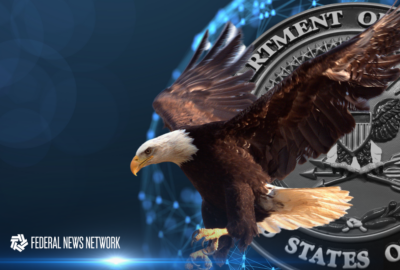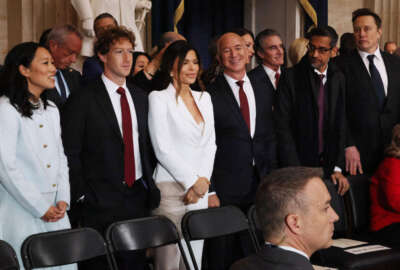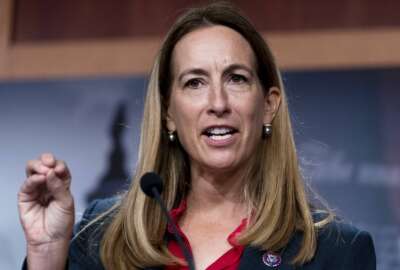John Ogren, the chief learning officer at the National Weather Service, which is a part of NOAA in the Commerce Department, said the agency uses YouTube videos, memory-jogger training and other approaches to ensure employees are ready for the coming weather season.
The Chief Learning Officer Role at the National Weather Service
The real shift has been to take that training role and make it part of that C-suite as part of the chief learning officer so we can now oversee the entire organization and train everyone that is out there.
John Ogren
Chief Learning Officer, National Weather Service
Leadership comes from all levels and those are the types of things that we start to lay down that foundation from the very first year you join the weather service. It took us a long time [to understand that]. About three years ago, we started a new hire orientation program. We bring every new hire to the weather service to Kansas City and really start laying down that foundation to create the culture that we want: leadership comes from everywhere and everyone plays a role in meeting the mission.
John Ogren
Chief Learning Officer, National Weather Service
Employee Retention, Course Work and Field Offices
The way we do it is that we are very blended. We try to use the right tool for the right job at the right time. There is a time and a place for computer based modules. Where we try to do that is pre-requisites. We want to lay down some foundational information for you. Maybe that’s all you need, and if so, that’s good. But we may take it to the next level where we have an instructor based webinar. We can have interactive classes, but we can do them at a distance. We’ve got PowerPoint presentations and video presentations. Technology allows us to be interactive with those things so we can have quiz questions, survey questions and ways to engage the student so they are just not sitting and listening to somebody read slides.
John Ogren
Chief Learning Officer, National Weather Service
We are acting more entrepreneurial. How can we come up with creative solutions to our training needs that fit within our budget? You tend to run a little bit more like a business than a government agency might necessarily do. It’s been a real mental shift for me. I found myself training, working on business classes and sales and project management because hopefully it makes me a better chief learning officer as well
John Ogren
Chief Learning Officer, National Weather Service
The National Weather Service’s training budget bottomed out after the 2013 sequester cuts took effect. It went from about $5 million to $825,000, and training for the 4,000 employees, which includes, meteorologists, hydrologists, climate experts, engineers, scientists, budget analysts, communications and administration staff, basically came to a screeching halt.
But the sequestration cuts also may have come at an opportunistic time.
Leadership at the National Weather Service, which is a part of NOAA in the Commerce Department, decided to reorganize and make training and the chief learning officer role more prominent.
Now six years later, John Ogren, the chief learning officer at NWS, said his budget is closer to $9 million, and training if focused on building a “weather-ready” staff across every position.
“The real shift has been to take that training role and make it part of that C-suite as part of the chief learning officer so we can now oversee the entire organization and train everyone that is out there,” Ogren said on Providing a Modern Learning Experience sponsored by Cornerstone OnDemand. “We are trying to modernize training. It’s slow and tedious. Are we there yet? Not completely. But have we made a lot of strides? Absolutely.”
Part of the reason Ogren has been able to help NWS rebound from the sequestration cuts over the last six years is not just the return of his budget, but the broad support his office is getting from management and the mission organizations, which span 122 weather forecast offices and nearly two dozen centers, such as the National Hurricane Center, the Space Weather Prediction Center, Storm Prediction Center and 12 river forecast centers.
“I don’t get a base budget. I work with the different portfolios within the weather service headquarters to fund that. The real benefit is they have skin in the game,” he said. “If we have a new piece of technology, like the new satellite that was just launched or if we have decision services and things like that and we are doing a nationwide rollout of something new, they have skin in the game. They know they have training needs and carve out a certain portion of their budget to help fund that training. The results have been incredible. Training budgets, as a result, have gone up because I don’t just manage a budget, but I have a lot of partners and a lot of stakeholders within the weather service that help fund the training.”
In-person and online training
Ogren said the partnership between the CLO office and the mission areas helped address some long standing challenges and bring some entrepreneurial ideas to the forefront.
“How can we come up with creative solutions to our training needs that fit within our budget? You tend to run a little bit more like a business than a government agency might necessarily do,” he said. “It’s been a real mental shift for me. I found myself training, working on business classes and sales and project management because hopefully it makes me a better chief learning officer as well,”
These learning innovations are both online and in person.
For instance, Ogren said NWS developed a new hire program about three years ago to lay the culture foundation that focuses on the idea that leadership comes from everywhere and everyone plays a role in meeting the mission.
“You very quickly realize that we are extremely reliant on one another and at any given moment you may be the one coming up with the idea or doing the act to save the day,” he said. “Another area we are working on is how do we do better about hiring effective managers and supervisors? But you don’t have to be a manager or supervisor to be successful in a career. If you are great forecaster and that’s what you want to do, that’s good and we like that.”trainingentre
As for the online innovations, Ogren said NWS is using everything from YouTube videos to just-in-time training to combining in-person with online training.
“The way we do it is that we are very blended. We try to use the right tool for the right job at the right time. There is a time and a place for computer based modules. Where we try to do that is pre-requisites. We want to lay down some foundational information for you. Maybe that’s all you need, and if so, that’s good. But we may take it to the next level where we have an instructor based webinar,” he said. “We can have interactive classes, but we can do them at a distance. We’ve got PowerPoint presentations and video presentations. Technology allows us to be interactive with those things so we can have quiz questions, survey questions and ways to engage the student so they are just not sitting and listening to somebody read slides.”
Instructional designers on staff
Ogren said NWS found that, for example, if a video is longer than say two minutes, employees stop paying attention so they need to get to the key points of the topic quickly.
He said NWS also has turned to micro-learning where employees take 30 minutes or 60 minutes that they can dedicate to a specific topic. For example, the new satellite NWS recently launched included 43 training modules, but most were just 15 minutes long.
Another innovation is for employees who need a reminder about technology or topics ahead of a new season. Ogren said it’s called memory jogger training.
“Maybe you’ve been trained on something but it’s been quite awhile since you’ve seen it. We are using new technology to have some training modules to have short videos or short documents on the workstations our forecasters are using,” he said. “For example if they are looking at satellite data and realize they haven’t used it since last winter, they can do a simple right click, which pops up a user guide and they can remember how it works.”
These and many other innovations come from the partnership with the mission users and because NWS brought instructional designers on staff, who help develop the courses.
“We are continually updating our courses. In the August or September timeframe, we will do our winter weather training so during the summer is when our instructors are making tweaks to that existing training. They are bringing in new satellite data or if there is new technology that is being implemented,” Ogren said. “We also do service assessments. Anytime there is a major weather event, we do an internal assessment. We talk to the media or emergency managers and ask how we did. We get a lot of feedback from our partners and we can integrate those new best practices into our training for the upcoming season.
Listen to the full show:
Copyright
© 2025 Federal News Network. All rights reserved. This website is not intended for users located within the European Economic Area.








